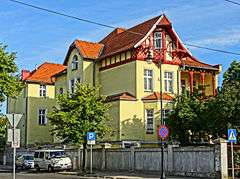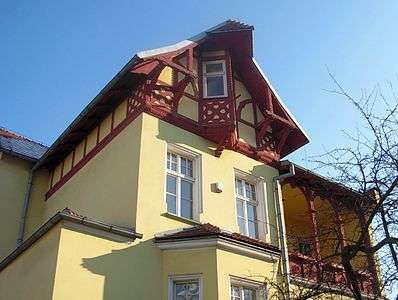Villa Carl Grosse in Bydgoszcz
| Villa Carl Grosse in Bydgoszcz | |
|---|---|
| Polish: Willa Carla Grosse w Bydgoszczy | |
 View from Gdanska street | |
 Location within Poland | |
| General information | |
| Type | Villa |
| Architectural style | German Historicism |
| Classification | N°601312-Reg.A/1079/1-2, 13th December 1994[1] |
| Location | Gdanska street 84, Bydgoszcz, Poland |
| Country | Poland |
| Coordinates | 53°7′59″N 18°0′40″E / 53.13306°N 18.01111°E |
| Construction started | 1898 |
| Completed | 1899 |
| Client | Carl Grosse |
| Technical details | |
| Floor count | 4 |
| Design and construction | |
| Architect | Karl Bergner |
| Wikimedia Commons has media related to Villa Carl Grosse. |
The Villa Carl Grosse is an historical house in downtown Bydgoszcz.
Location
The building is somehow setback on the eastern side of Gdanska Street (N°84), at the intersection with Zamoyski street.
History
The villa was built in 1898-1899 by architect Karl Bergner, following an order from Carl Grosse.
Mr Grosse ran in Bydgoszcz a cork factory (German: Ostdeutsche Kork-Fabrik), with the company seat here (Danzigerstrasse 127).[2]
A subsequent owner - wood wholesaler Otto Schmidt - in the years 1918-1920 enriched the villa: it is the decor that is still preserved today.
The building has undergone many renovations with succeeding owners and users. For many years in the 1920s, rumor went that the villa belonged to actress Apolonia Chalupiec, aka Pola Negri, from which it had been purchased by industrialist Jan Kłossowski, called "cardboard king", who lived there with his family in the 1930s. In reality, Jan Kłossowski bought the villa from the Bank Ludowy[3] (German: Volksbank) in Bydgoszcz and Pola Negri's house was located at Zamoyski street 8.
Between 1962 and 1992 the building was the headquarters of the Civic Militia (MO), with a factory shop and a cafeteria.[4]
Architecture
The tenement is decorated in a style referring to German Historicism.[5] The villa is separated from the street by a garden. Its facade has an asymmetric block, adorned with decorative bays, avant-corpss, loggias and post-and-plank structures.
The interior is designed in art deco style, by Johanna H. Fricke. In addition to the stuccoes, worth noticing are stained glass, wooden reliefs (animal and plant motifs) and handrail stairwell. In the ballroom overlooking the garden is placed a fountain decorated with a sculpture of a woman washing her hair.
The building has been put on the Pomeranian heritage list (N°601312-Reg.A/1079/1-2) on December 13, 1994.[1]
Gallery
- View from the garden
- View from the garden
 Zoom on the facade
Zoom on the facade- Detail of a gable
See also
- Gdanska Street in Bydgoszcz
- (Polish) Karl Bergner
- (Polish) Downtown district in Bydgoszcz
Bibliography
- (Polish) Bręczewska-Kulesza Daria, Derkowska-Kostkowska Bogna, Wysocka A., Ulica Gdańska. Przewodnik historyczny, Bydgoszcz 2003
- (Polish) Czajkowski Edmund: Na marginesie pewnej informacji. Kalendarz Bydgoski 1987
References
- 1 2 zabytek-kujawsko-pomorskie issued 28.02.2014
- ↑ Addressbuch nebst allgemeinem Geschäfts-Anzeiger von Bromberg und dessen Vororten auf das Jahr 1900 : auf Grund amtlicher und privater Unterlagen. Bromberg: Dittmann. 1900. p. 163.
- ↑ "corporations". Książka Adresowa Miasta Bydgoszczy: na rok 1933. Bydgoszcz: "Bibljoteka Polska" w Bydgoszczy. 1933. p. 6.
- ↑ Bydgoszcz Guide. Bydgoszcz: City of Bydgoszcz. July 2014. p. 83. ISBN 83-917786-7-3.
- ↑ Bręczewska-Kulesza Daria, Derkowska-Kostkowska Bogna, Wysocka A (2003). Ulica Gdańska. Przewodnik historyczny. Bydgoszcz: Wojewódzki Ośrodek Kultury w Bydgoszczy. ISBN 8386970103.